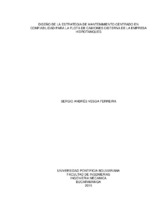| dc.contributor.advisor | Director. Plata Villamizar, Rossvan Johan | |
| dc.contributor.author | Vesga Ferreira, Sergio Andrés | |
| dc.coverage.temporal | 2019 | |
| dc.date.accessioned | 2021-05-14T16:54:55Z | |
| dc.date.available | 2021-05-14T16:54:55Z | |
| dc.date.issued | 2019-11 | |
| dc.identifier.uri | http://hdl.handle.net/20.500.11912/8541 | |
| dc.description | 134p.: (pdf); il; imágenes; tablas; anexos. | spa |
| dc.description.abstract | El presente trabajo consistió en diseñar la estrategia de mantenimiento centrado en la confiabilidad (RCM) para la flota de 19 camiones cisterna pertenecientes a la empresa Hidrotanques. la cual realizó procesos de mantenimiento de tipo reactivo, estableciendo planes de contingencia orientados a reparar específicamente fallas que surgieron de manera inesperadas. A través del documento se contemplan las cuatro fases que conforman la base fundamental de diseño, iniciando por la fase de caracterización del parque automotor que permitió definir e identificar los diferentes sistemas que conforman el activo y crear su ficha técnica, la fase investigativa del histórico de fallas que permitió detectar la falencia de no contar con registros históricos lo que surgió la necesidad de crear una planilla de registro semanal de falla, la fase de diseño de la estrategia que se basó en la norma SAE J1739 la cual guío al autor a través de las siete preguntas claves del RCM y obtención final mediante la hoja de cálculo del análisis de modo y efecto de falla (AMEF) diseñada específicamente para automotores y por último la fase GMAO que consistió en la gestión del plan de mantenimiento preventivo y creación de ordenes de trabajo con documento soporte a través de herramienta propuesta e implementada por el autor. | spa |
| dc.description.abstract | This work consisted of designing the reliability-focused maintenance strategy (RCM) for the fleet of 19 tanker trucks belonging to the company Hidrotanques. which carried out reactive-type maintenance processes, establishing contingency plans aimed at specifically repairing failures that unexpectedly arose. The document includes the four phases that make up the fundamental design base, starting with the characterization phase of the automotive park that allowed to define and identify the different systems that make up the asset and create its technical data sheet, the the research phase of the fault history that made it possible to detect the lack of lack of historical records which arose the need to create a weekly failure record sheet, the design phase of the strategy that was based on the SAE J1739 standard which guided the author through the seven key questions of RCM and final obtaining through the Mode and Effect of Failure Analysis (AMEF) spreadsheet designed specifically for motor vehicles and finally the CMMS phase that consisted of managing the preventive maintenance plan and the creation of work orders with support document through tool proposed and implemented by the author. | eng |
| dc.format.mimetype | application/pdf | |
| dc.language.iso | spa | |
| dc.publisher | Universidad Pontificia Bolivariana | spa |
| dc.rights | Attribution-NonCommercial-NoDerivatives 4.0 International | * |
| dc.rights.uri | http://creativecommons.org/licenses/by-nc-nd/4.0/ | * |
| dc.subject | Empresas - Hidrotanques | spa |
| dc.subject | Mecánica automotriz | spa |
| dc.subject | Plan de contingencia | spa |
| dc.subject | Mantenimiento | spa |
| dc.subject | RCM | spa |
| dc.subject | SAE J1739 | spa |
| dc.subject | GMAO | spa |
| dc.subject | AMEF | spa |
| dc.title | Diseño de la estrategia de mantenimiento centrado en confiabilidad para la flota de camiones cisterna de la empresa hidrotanques | spa |
| dc.type | Trabajo de grado | spa |
| dc.publisher.department | Escuela de Ingenierías | spa |
| dc.publisher.program | Ingeniería Mecánica | spa |
| dc.type.hasVersion | publishedVersion | spa |
| dc.description.sectional | Bucaramanga | spa |
| dc.description.degreename | Ingeniero Mecánico | spa |


